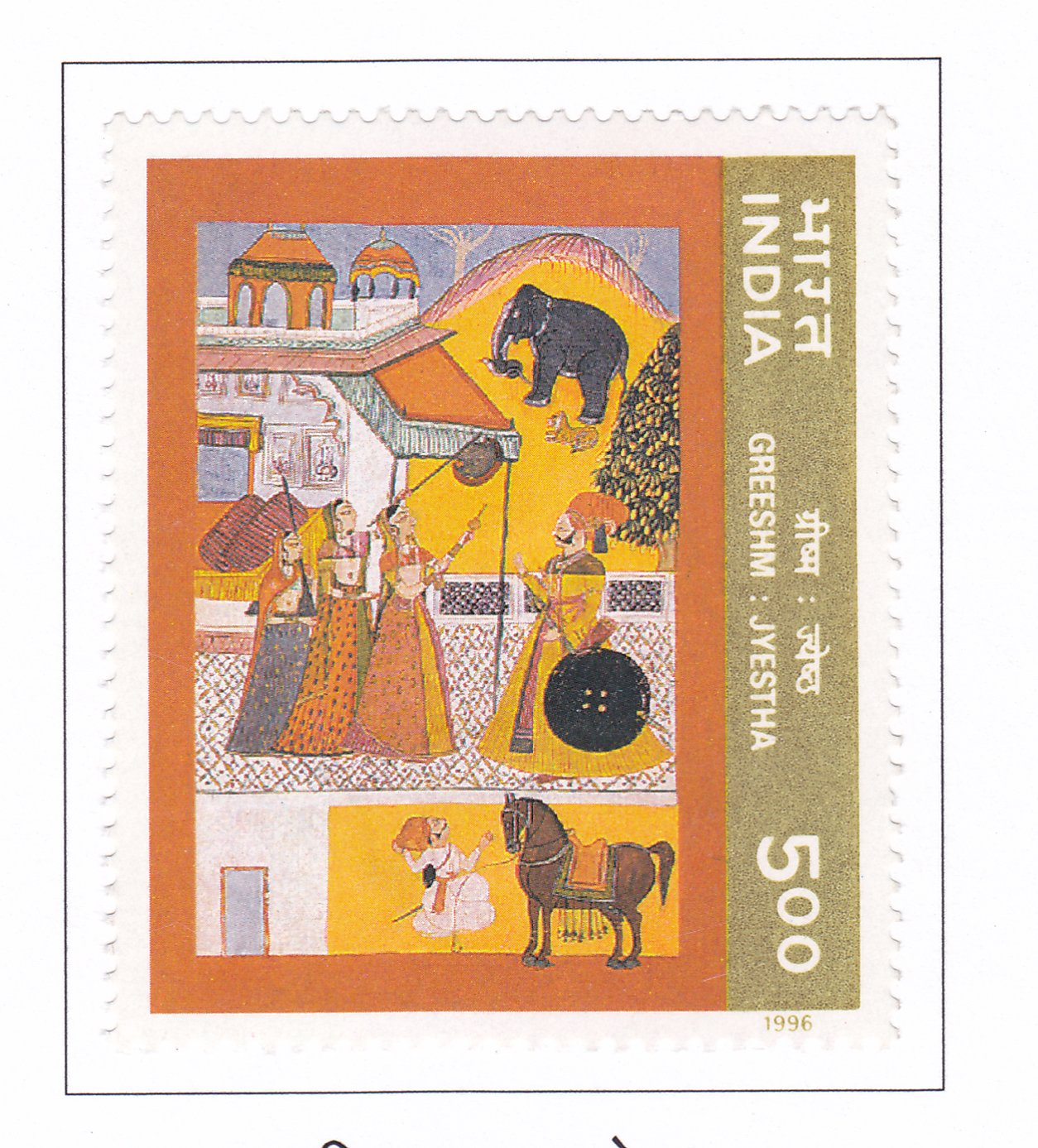Ritu Rang – “Greeshm” (Summer) (Jyestha)

Technical Data
| Stamp Set | Paintings of the Seasons |
|---|---|
| Date of Issue | March 13, 1996 |
| Denomination | Rs. 5 |
| Quantity | 1,000,000 |
| Perforation | comb 13½ |
| Printer | Security Printing Press, Nashik |
| Watermark | No Watermark |
| Colors | Multicolor |
| Catalog Codes |
Michel IN 1492 Stamp Number IN 1558 Yvert et Tellier IN 1301C Stanley Gibbons IN 1659 |
| Themes | Animals (Fauna) | Art | Elephants | Mammals | Paintings | Seasons |
Table of Contents
Ritu Rang – Greeshm
India’s cultural and artistic heritage is richly illustrated through various art forms, and Indian Miniature Painting stands out as a remarkable expression of this legacy. Originating with the Mughals, this art form evolved to incorporate diverse themes and regional styles, reflecting the intricate tapestry of India’s history and culture.
Indian Miniature Painting: An Overview
Origins and Evolution:
Indian Miniature Painting began in the Mughal courts, depicting scenes of grandeur, court life, and historical events. As the art form spread across different regions, such as Kangra, Rajasthan, and the Deccan, it absorbed local influences, resulting in distinct sub-schools of miniature painting. These regional styles enriched the art form, leading to a vibrant and varied artistic tradition.
Poetic and Artistic Fusion:
The charm of Indian Miniature Painting is further enhanced by its incorporation of poetry. Works like Jayadeva’s “Gita Govinda” and Keshav Das’s “Kavipriya” and “Rasikpriya” are reflected in the miniatures, blending poetic expression with visual artistry. This fusion creates a harmonious representation of romantic and mystical themes, capturing the essence of the written word in intricate and colorful details.
Seasonal Depictions:
Indian Miniature Paintings often depict the six seasons of India—Vasant (Spring), Greeshm (Summer), Varsha (Monsoon), Sharad (Autumn), Hemant (Winter), and Shishir (Late Winter). This tradition is rooted in Kalidasa’s “Ritusamhara,” where each season is celebrated through romantic and lyrical language. The tradition continued with various writers and artists celebrating the beauty of each season.
“Ritu Rang” Stamps by India Post
India Post’s “Ritu Rang” set of stamps pays tribute to this rich tradition of Indian Miniature Painting, featuring four seasons: Vasant, Greeshm, Varsha, and Hemant.
- Vasant (Spring):
- Depiction: A painting on Rag Basanti, a musical mode representing the spirit of spring.
- Essence: The artwork captures the vibrancy and renewal associated with spring, with floral motifs and bright colors reflecting the season’s freshness.
- Greeshm (Summer):
- Depiction: The intense heat of summer, as shown through the plight of a warrior deterred from his campaign.
- Essence: The painting highlights the sweltering heat and its impact on daily life, with a hazy atmosphere and subdued colors representing the summer’s heat.
- Varsha (Monsoon):
- Depiction: Illustrated in Rag Megh Malhar, this painting celebrates the life-giving rain of the monsoon.
- Essence: The artwork features rain, lightning, and scenes of revelry, reflecting the joy and relief brought by the monsoons.
- Hemant (Winter):
- Depiction: The heart of winter, with warmth provided by fire and the comfort of quilts.
- Essence: The painting captures the cold, serene atmosphere of winter, with cozy interiors and a sense of stillness.
Conclusion
The “Ritu Rang” stamp set by India Post beautifully encapsulates the essence of Indian Miniature Painting and the celebration of the seasons. Each stamp reflects the unique characteristics of the depicted season, blending traditional art with poetic and natural themes. This special issue, along with its first-day cover and cancellation design, is a testament to India’s artistic heritage and its continued reverence for the artistic portrayal of life and nature.
